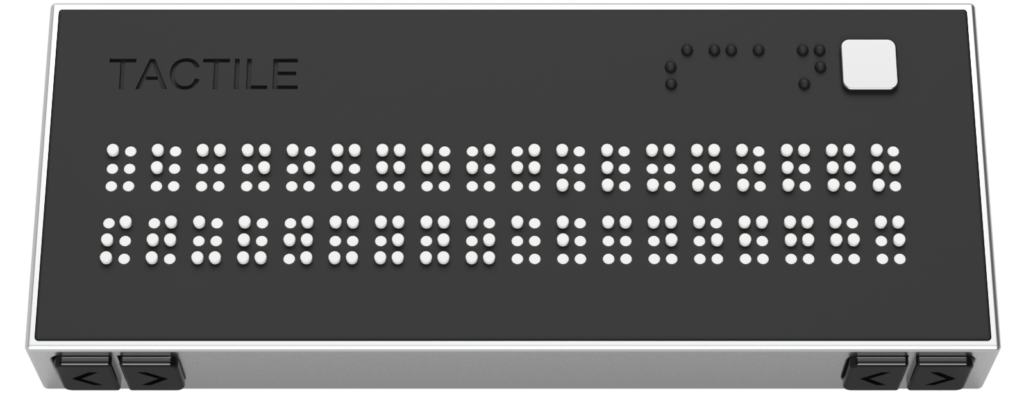Tactile is a hardware product that converts any text into Braille. The braille reader has a refreshable braille display, scanning system, and OCR. With Tactile, a user can scan any printed document, such as mail, menu, or flyers, and immediately get the information back in Braille. Additionally, there is a companion app where documents can be saved for future reference.
Tactile was conceptualised at the annual MakeMIT Hackathon by a team of six MIT students who entered the hackathon under the name “100% Enthusiasm.” The most important feature of the device is the braille keyboard to allows users to easily read text. The way the device they created works is by sliding the text to braille converter over printed text and a camera captures images of the words and sends them to a microcontroller. In the version from the hackathon, the reader could display 6 letters. The information moves the pins up and down, translating the text into Braille. The desired device will have many more cells to make reading faster and easier. The Tactile device aims to address the functional model of disability because it aims to improve on current text-to-braille converters and make them even better.
Another important feature of the converter is that it will have a companion app. This is very helpful as in everyday life non-vision impaired people can look at flyers and posters and if they see something interesting take a quick picture to refer to later. What’s great about the Tactile device is that it will have a companion app. Once a user scans a poster with the Tactile device, they can then save that document’s information to the companion app for future reference. This is particularly helpful because a lot of text is not readily available in an electronic format (brochures, receipts, business cards). But with the tactile device being able to scan documents in real-time (such as a brochure), users can quickly scan the brochure and save it to the companion app, and then read the brochure later when they have time.
Currently, the options for those who are vision-impaired are screen readers and books that are printed in Braille. Additionally, it is difficult to find books printed in Braille as they can be quite costly to produce, and screen readers can be expensive to purchase (as much as $1200 USD). Tactile is an instant text to braille converter. An important feature of the braille-to-text converter is that it has a refreshable braille display so that people can read documents in real-time. Currently, there is no real-time text to braille convertors. The closest option that currently exists is HumanWare Brilliant which can connect to mobile devices or computers and has a six-keyed braille keyboard that allows users to read its characters. However, that device costs $2,500.
Tactile will provide affordability and accessibility. The goal stated by Team Tactile is that each Tactile device’s price point is $100USD, and the size of Tactile is the size of a candy bar which makes it easily portable. In the aspect of the social model of disability, the Tactile device is great because users can just quickly scan and read using a small device that isn’t glaring to the eye and make it obvious that a user is visually impaired. They do not have to find a place to sit, take out a laptop, hook up the device to the laptop, and then read using a clunky braille keyboard.
Conclusion
Tactile is a groundbreaking technology that will allow those that are vision-impaired to gain back some autonomy in their life. No longer will they only be able to use their phone or laptop/PC with built-in screen readers to be able to read digital text. Now, they can quickly read handouts or flyers that they are given in passing and then recycle the paper if they do not think the content of a flyer is necessary to keep. Or, they can save the document to read for later.
Video about tactile: https://www.youtube.com/watch?v=bz8trtx7Ozg&t=81s&ab_channel=LemelsonMIT
